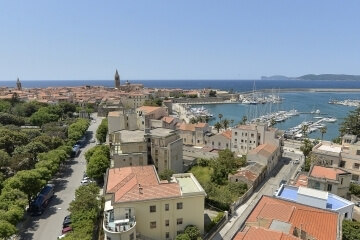Alghero
History, nature and interesting facts
Brief historical notes and origins of the ciutad
Alghero, known as Italy's Barceloneta (little Barcelona), was founded in the XII century by the powerful Doria family, who skillfully took advantage of the strategic location of Alghero, building one of the most prominent examples of military architecture on the whole island. Despite the various changes, the fortifications still have a distinctive presence today, with the defence towers framing the ominous and harmonious architectonic seafront design.
The town has been occupied by various colonists over the centuries, but the Pisa domination was the one that altered both the look and spirit of the town and above all the language. In 1354 the expansion policy of the Crown of Aragon reached Alghero, which, by the hand of Peter IV "the Ceremonious" of Aragon, was then purged and transformed, in just a short period of time, into one of the many colonies that orbited around the central power of the kingdom.
The prized examples of Gothic-Catalan architecture located within the urban centre, form a unique, lavish, and permanent proof of the Catalan passage.
A notable example of this is provided by the church of San Francesco, which conforms to the architectonic models of the eastern Spanish, with its characteristic star-shaped vault in the presbytery, and the evocative internal cloisters. The linguistic heritage is yet more surprising: the local variant of Catalan – Algherese – is still alive, vivid and spoken among today's inhabitants.
Although Alguer was founded only relatively "recently," the surrounding area is dotted with settlements of much more remote origin and of absolute historical importance as evidenced by the imposing Nuragic complex of Palmavera, and the discovery of Sant'Imbenia in the 1980s. Right next to the Sant "Imbenia complex, located in the enchanting bay of Porto Conte (the only natural harbour in Sardinia), previously known as Portus Ninpharum as mentioned in Ptolemy's geography, the remains of a villa dating back to Roman times can still be seen today.
Another site of great interest and the largest of the graveyard complexes in the region is the pre-Nuragic necropolis of Anghelo Ruju, located near the road "Dei Due Mari" running from Alghero to Porto Torres - and easily accessible from the airport.
The Catalan community, activities and religion
The historic centre of the town, and in particular the town market, remains the central hub of commerce and craftsmanship. Among these, are the fishing-related activities and the workings of precious red coral. Red coral is the symbol of the town which, undoubtedly, is located within the Coral Riviera.
The ancient ciutad acquires an indescribable allure during the rites of holy week, which can be traced back to the religious Catalan culture. During this period, the mysteries linked to the cult of passion, with the sacred drama of the disclavament (descending) and the Good Friday procession of the image of the wooden Christ, attracts visitors from all over the world.
The sea and the coastline: an invaluable heritage
Few areas of Sardinia offer a landscape that is quite so varied and significant. Starting from the previously mentioned Baia delle Ninfe, in the area of Le Prigionette, located in the regional park of Porto Conte a must see is the protected area 'Arca di Noè.' 350 hectares of land provides homes to many different species of animals, such as the beautiful small horses, 'Cavallino della Giara.' Continuing along the route over the "sleeping calcareous giant" of Capo Caccia (Caput Hermeum), we come across the rather grand vision of cliffs with a sheer drop to the sea, the nineteenth century lighthouse, and Foradada island, inhabited by many different species of marine birds, such as Cormorants and Andouin's gulls. The famous Neptune's Cave, dating back to the Cretaceous period, is of extraordinary, transcendent beauty. The cave can be reached by descending the 656 steps of the Escala del Cabirol carved into the cliff wall, down to sea level, or by an equally spectacular, and no doubt more comfortable, boat trip from the town harbour.
The eighty kilometres of coastline, starting from the most north western tip (Capo Caccia) and running to the beach of Poglina, have much to offer.
When exploring the coasts, in a southerly direction, admire the landscape of the beautiful fine sandy beaches (Lazzaretto and Bombarde), and stop by the village of Fertilia – an interesting example of rationalist architecture. At the most southern point of Alghero, you can find the beautiful Alghero-Bosa coastline. This wild and entirely uncontaminated panoramic route winds through hairpin bends around the cliff edges. It is named among the best in Europe for its beauty.
Interesting Facts
The golden age of tourism in Sardinia, brought about an unforeseen season of "Hollywood Stardom," welcoming the cast of Losey's film Boom! (1968) The Filming took place on the island of Sardinia at Porto Conte's Natural Park near Alghero, and it starred both Liz Taylor and Richard Burton.
Pictures by Andrea Montalbano
Suggestions and complaints
Send us a complaint or a suggestion








